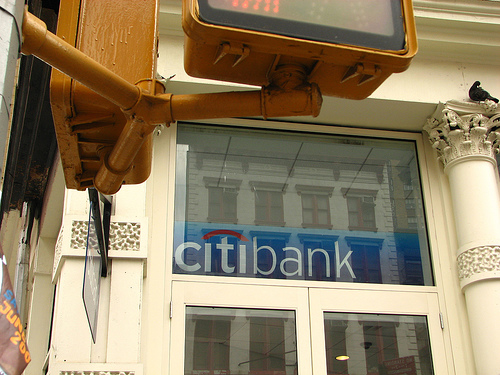
Handling the Bank Bailouts

Photo by: epicharmus
As of this writing, the Citibank closed the previous day’s trading at $1.20 per share. This gives them a market capitalization of just over $6 billion dollars. Specifically, this means all the common stock of Citibank is worth $6 billion dollars. In November, the US Government “injected” $20 billion and guaranteed $306 billion of Citibank’s assets. Citibank has been “bailed out” repeatedly and has had a total of $45 billion of taxpayer money channeled to it.1 This leads to one simple question:
How is Citibank Solvent?
Of course the answer is, it isn’t. But that leads to the question: how is its common stock still worth $6 billion?
Currently the governmnet is propping up a company to retain value for investors who should have been wiped out already. Sure they have been diluted by government injections, but that seems a poor punishment for investing in an utterly insolvent company.
Nationalization
Many people like to jump up and down about the subject of nationalization, making the comment that we’re going to somehow become “socialist” if we take this approach. This argument somehow overlooks the fact that the government already owns 36% of Citigroup. We already own the banks, at least partially, and given what we guarantee we deserve to own them outright. Additionally, the Federal Reserve’s regulatory oversight powers give it the authority to direct bank policy if necessary even without any equity stake.2
It is not necessary that nationalization be permanent. In fact it could be both temporary and brief. It could serve as an orderly receivership process with the government acting as receiver in much the same manner as it did during the early 1990’s with the Resolution Trust Corporation that liquidated the assets of a hundreds of busted savings and loans. They “clean up” the banks by selling off assets and cramming down debt holders and then reissue the stock (in some cases in lieu of old debt) and we all move on with solvent banks instead of insolvent ones.3
Another argument made against this approach is that it will be bad for stocks, particularly bank stocks. This argument is probably true, but seems irrelevant to me. Maintaining stock market value is not the sole purpose of fiscal policy. The true goal is to get the system “fixed” as quickly as possible, instead of trying to control the market, a proposition that is almost certainly doomed to fail.
Bond Holders
Many people have notably criticized the idea of nationalization. The most common question is: What happens to bond holders? These banks have bonds to insurance companies and pension funds. If that debt is wiped out, then we just have a new set of problems. ((Washington Post – Nationalize the Banks! We’re all Swedes Now)) This works under the assumption that you have to wipe them out, or wipe them out completely. There are many approaches to this, including leaving them completely intact. Morally it seems appropriate however that those who bought bonds from insolvent banks endure at least a small portion of the pain of restructuring them.
A Naïve Solution
Ultimately the idea of “cleaning up” these banks and reissuing their stock has a wide variety of pitfalls and details to be worked out. On the plus side, it has the huge advantage that the right people are at least contributing to the solution. Imagine this most simplified of solutions:
The government nationalizes the banks, spends $6 billion to improve their balance sheets, wipes out all the common stockholders and re-sells their shares at the exact same price they nationalized at. You suddenly have a bank with $6 billion more in assets, which should certainly be worth more than the current institutions, particularly without the specter of nationalization hanging over their heads. The government has spent essentially nothing and the only people footing the bill are common shareholders, who it only makes sense should be wiped out in the process. Of course $6 billion is unlikely to be enough, so perhaps we make the bond holders pay a bit of the price too. While it seems likely that the government might have to inject some taxpayer money, it also seems likely that a recapitalized bank could likely be resold to the public at a higher price than it currently enjoys.
Obviously, this solution is naïve and there are tremendously more complex details. But at a bare minimum it makes sense that those who invested in these doomed banks bear the brunt of the restructuring costs, versus taxpayers who had nothing to do with them.













Leave a Reply